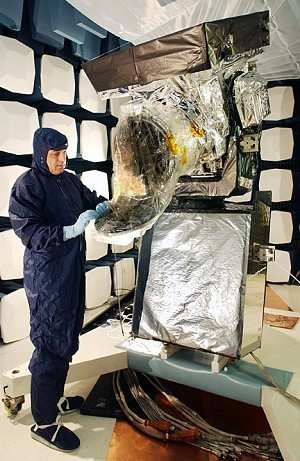Will Search The Planet For Signs Of Missile Launches
 Lockheed Martin says it's delivered
a second Highly Elliptical Orbit (HEO 2) payload, a critical
element of the nation's next-generation missile warning system,
known at the Space-Based Infrared System (SBIRS) program.
Lockheed Martin says it's delivered
a second Highly Elliptical Orbit (HEO 2) payload, a critical
element of the nation's next-generation missile warning system,
known at the Space-Based Infrared System (SBIRS) program.
The payload ultimately will be integrated with a host satellite
and launched into a highly elliptical orbit to globally scan for,
detect and report missile launches and other infrared events of
military interest. Lockheed Martin Space Systems, Sunnyvale, CA,
the SBIRS prime contractor, and its subcontractor Northrop Grumman
Electronic Systems, Azusa, CA, built the two HEO payloads for the
US Air Force Space and Missile Systems Center, Los Angeles Air
Force Base. The first payload was delivered to the Air Force in
August 2004.
In addition to providing early warning of missile launches,
SBIRS will support other missions simultaneously, including missile
defense, technical intelligence and battlespace characterization.
SBIRS will augment missile defense by providing the earliest
possible warning of ballistic and theatre missile attacks and
accurate information to effectively cue other ballistic missile
defense system elements to support intercept and negation of the
threat. Improved capabilities for technical intelligence will
enable combat commanders the flexibility to gain valuable insight
into an adversary's battlespace and provide both tactical and
strategic missile warning around the globe.
 "This critical milestone is the
result of our relentless focus and commitment to successfully
executing the SBIRS program," said Joanne Maguire, vice president
and deputy, Lockheed Martin Space Systems Company. "This payload
will deliver faster, more accurate data to the warfighter, and
serve as an essential component of a successful missile defense
architecture. We look forward to our continued positive momentum on
SBIRS and achieving mission success for our customer."
"This critical milestone is the
result of our relentless focus and commitment to successfully
executing the SBIRS program," said Joanne Maguire, vice president
and deputy, Lockheed Martin Space Systems Company. "This payload
will deliver faster, more accurate data to the warfighter, and
serve as an essential component of a successful missile defense
architecture. We look forward to our continued positive momentum on
SBIRS and achieving mission success for our customer."
Col. Randy Weidenheimer, the US Air Force's SBIRS program
manager, said, "the Air Force sees the delivery of the HEO 2
payload, which has better technical performance than its
predecessor, as another major milestone for the SBIRS program, and
tangible evidence that the program has turned the corner on several
developmental issues that hampered completion of the payloads. This
next-generation sensor will deliver state-of-the art, multi-mission
capability to a myriad of defense and intelligence users for many
years to come, setting a new operational standard for global
surveillance, tracking, and targeting support."
When fully operational, SBIRS High will comprise two payloads in
highly elliptical orbit, four satellites in geosynchronous orbit,
as well as fixed and mobile ground-based assets to receive and
process the infrared data. The team is progressing on the first of
the SBIRS High geosynchronous orbit (GEO) satellites and is on
track to begin final integration and test of the first GEO
satellite later this year in preparation for launch in fiscal year
2008.
"Northrop Grumman remains committed to delivering this critical
capability to support our nation's missile defense needs," said Bob
Iorizzo, president, Northrop Grumman's Electronic Systems sector.
"The delivery of HEO 2 shows our continuing dedication to meeting
performance and schedule goals for SBIRS High."
SBIRS High already is providing the nation enhanced worldwide
missile detection and tracking capabilities, battlefield data, and
technical intelligence through its consolidated ground segment
operations at Air Force Space Command, Buckley Air Force Base,
Colo.
 ANN's Daily Aero-Term (04.14.24): Maximum Authorized Altitude
ANN's Daily Aero-Term (04.14.24): Maximum Authorized Altitude ANN's Daily Aero-Linx (04.14.24)
ANN's Daily Aero-Linx (04.14.24) Classic Aero-TV: 'We're Surviving'-- Kyle Franklin Describes Airshow Life 2013
Classic Aero-TV: 'We're Surviving'-- Kyle Franklin Describes Airshow Life 2013 Aero-News: Quote of the Day (04.14.24)
Aero-News: Quote of the Day (04.14.24) Airborne 04.09.24: SnF24!, Piper-DeltaHawk!, Fisher Update, Junkers
Airborne 04.09.24: SnF24!, Piper-DeltaHawk!, Fisher Update, Junkers




